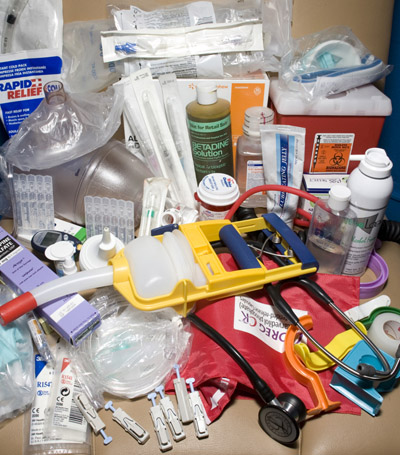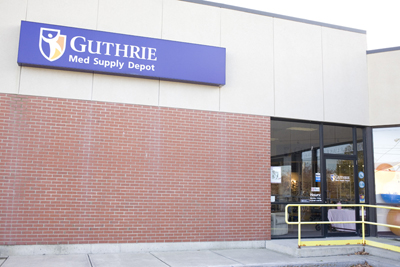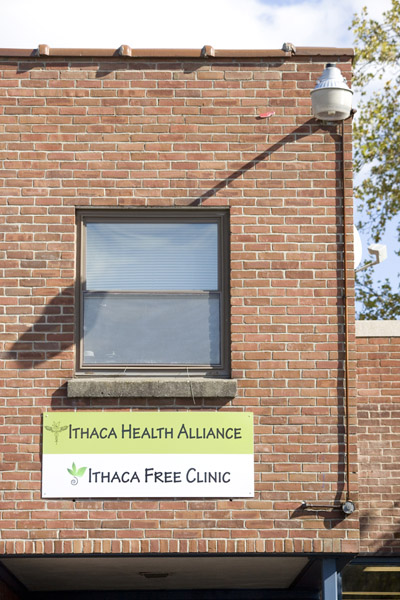Simon St.Laurent: October 2008 Archives
A Local Health Resource Assessment
By Bethany Schroeder
Through an ongoing application of fiscal resources, professional collaboration, and continuous assessment, the legislative, medical, and social work communities of Tompkins County have created a network of health services that largely complement one another. The degree to which the network remains integrated as peak oil and climate change influence the region will be a matter of planning, depending on the approach the community and its formal and informal leaders take.
The purpose of this overview is to describe broadly the infrastructure available in the County, so as to quantify local medical care, with a view to planning for access to services despite fewer resources. If, as anticipated, travel from one part of the County to another in the next 10 to 20 years becomes increasingly expensive, planning alternatives to present automobile-oriented patterns of care will be the best way to assure a healthy community. Similarly, the cost of producing and distributing required supplies at the end of long supply chains may become prohibitive, either because of decreasing availability of materials from which the supplies are made or because of the cost of transporting them. In short, decisions about developing, using, and husbanding local physical and human resources are necessary if we are to provide health care to residents in an energy-constrained environment.

Almost all medical supplies rely on petroleum for
manufacture and transport. Plastics are actually made out of
fossil fuels.
Tompkins County Medical Infrastructure and Human Resources
With a population of just over 100,000 people, Tompkins County supports myriad health services, many already integrated into a system of referral sources organized to serve the needs of local people.
The largest health service is also the County’s only hospital, Cayuga Medical Center (CMC), which is also one of the largest employers in the region. Over 250 physicians have privileges at CMC, and they work with more than 1000 staff members, including nurse practitioners (NPs), physician assistants (PAs), registered and licensed vocational nurses, physical and occupational therapists, nutritionists, radiological technicians, and other healthcare professionals and support staff, just to give a few examples. (Most of the 250 physicians noted above and many of the 75 or more NPs in the County have local private or group offices; a small number of physicians have private practices but do not maintain privileges at CMC.) The hospital is licensed for 204 beds but has square footage for many more, even by modern medical standards, and thus could accommodate more people in an emergency. CMC and its outpatient offices report serving 150,000 patients annually, many of whom sought care outside the Finger Lakes region until technological advances in diagnosis and treatment became available at CMC. At present CMC provides general and specialized care across the lifespan; through its multiple affiliations with other medical facilities and schools, CMC can claim with confidence the ability to treat a wide array of human ailments.
Clinic and urgent care services in the County are available through Guthrie Medical Group, based in Sayre, Pennsylvania; through CMC’s urgent care offices; and through the Ithaca Free Clinic (IFC).
The Guthrie Medical Group offers primary and specialty care; diagnostics, including laboratory and radiology services; and supplies, such as medical equipment and oxygen. Patients who select Guthrie can opt for inpatient, outpatient, and emergency care at Robert Packer Hospital in Pennsylvania; most Guthrie physicians are affiliated with CMC as well.

Guthrie is an important local source of home medical
supplies.
CMC’s Convenient Care Center provides urgent and surgical care; radiological, laboratory, and imaging services; and sports and rehabilitation medicine. The Center also contracts to provide space to the Veterans Administration of Syracuse, which then offers outpatient services to local veterans. Many of the physicians who work at Convenient Care are affiliated with the hospital and have admitting and attending privileges at CMC. Both the Guthrie Clinic and CMC’s Convenient Care employ dozens of professional, ancillary, and support staff, including mid-level providers such as NPs and PAs.
At the other end of the technological spectrum is the Ithaca Free Clinic, where the County’s un- and under-insured residents receive care three afternoons a week. Staffed by volunteer retired physicians and the occasional NP or PA, IFC achieves its goals with the help of volunteer registered nurses, nutritionists, occupational and physical therapists, and administrative personnel. IFC is one of only two medically integrated free clinics in the United States. Alongside conventional or allopathic clinicians at IFC is a group of volunteer complementary and alternative providers, including a chiropractor, an herbalist, a licensed acupuncturist, and a massage therapist. Apart from simple urinalysis, random blood sugar analysis, and on-site electrocardiography testing, however, IFC offers no technical diagnostic services.

The Ithaca Free Clinic provides primary medical care for
more than a thousand uninsured local residents.
Additional resources are available through an array of complementary and alternative medical (CAM) practitioners in the County. Complementary care is designed to complete or to enhance a person’s state of well-being, especially from a holistic point of view that considers the prevention of illness, the promotion of healthy behaviors, and the use of alternative products, such as herbs and oils. Local CAM practitioners include more than 35 chiropractors and 15 acupuncturists. The services of several herbalists are available to the community; others have been trained, may practice informally, and continue to reside in the area. Reflexologists, naturopaths, homeopaths, massage therapists, and other CAM providers practice in various settings in the area, although their numbers are difficult to quantify. Many of these care givers support themselves by way of other skills in order to make a living.
In addition to therapy services available in institutional settings, occupational, physical, and speech therapists work in private local offices. The services of audiologists and social workers are available in the larger institutions and through private offices as well. Similarly, several psychologists and psychiatrists practice locally, some in collaboration with other area programs, some in their own or shared offices. Nutritional services are available privately, through the schools, and through a variety of area programs, including Cornell Cooperative Extension, which sponsors programs that provide counseling, nutritional awareness, and basic education in food safety and preparation.
Cornell University and Ithaca College have student health centers, where students can receive specific levels of care, depending on the school’s resources. Gannett Health Center at Cornell offers medical care, including a full range of diagnostic services, as well as physical and psycho-social therapy services. The Hammond Health Center at Ithaca College provides a similar level of primary care to students, including laboratory and radiology services. Both health centers refer students to CMC for inpatient care, and both have extensive collaborative relationships with care providers in the larger community.
Several skilled nursing facilities (SNFs) give medical and nursing care and shelter to more than 600 area senior residents: Beechtree Care Center, Groton Nursing Facility, Kendal at Ithaca, Lakeside Nursing and Rehabilitation Center, Longview, and Oak Hill Manor. A number of houses for people, mostly seniors, who have conditions that require specialized care include Bridges Cornell Heights, Sterling House, and Claire Bridge. These facilities offer assisted living to residents who have functional limitations up to a specific level, at which time patients might be transferred to other facilities with the capacity to provide higher levels of care. Additional assisted living services are available in Dryden, Newfield, and Trumansburg. SNFs typically maintain most of the equipment needed for basic care, including respiratory, intravenous, and pharmaceutical supplies, whereas assisted living homes are licensed to provide occasional help rather than full support to residents. Housing primarily youngsters and adults with chronic developmental conditions, at least nine Franziska Racker Centers operate in Tomkins County. Limited unlicensed care is available 24 hours a day in these residential settings.
Two free-standing home health programs exist in Tompkins County. The Tompkins County Public Health Department (TCPHD) has programs in health promotion, communicable diseases, immunization clinics, obstetrical and maternal services (MOMS), home health care, and nutritional aid to woman and infants (WIC). Several programs for children with special care needs are available at TCPHD, along with bioterrorism preparedness, a flu hotline, and departments of environmental health, health and safety, and vital records. In total, the staff—registered nurses, physical and occupational therapists, nutritionists, and others—serve hundreds of patients in the community each year. The second local licensed home health agency, Visiting Nurse Services, also provides a range of intermittent services to homebound patients; in addition, this agency has social workers available to its patients. The county has one free-standing licensed hospice, Hospicare. This agency offers home visits and 24-hour care in its six-bed residential unit.
More than 60 dentists practice in the County, including generalists, periodontists, orthodontists, and oral surgeons. Dental hygienists and dental assistants are typically employed in dental offices as well, and most dental practices have most if not all of the equipment required for diagnosis and treatment of dental conditions. Ithaca is also regularly visited by American Mobile Dental, a dental van completely outfitted for every manner of oral care. The service is particularly helpful to people with Medicaid, since few area dentists take state insurance reimbursements.
Several optometrists and ophthalmologists have offices in the County. Such services are also featured in some of the larger retail stores—especially the “big box” stores. At least one area optometrist offers complementary services in his office, and he is recognized among CAM practitioners for his work in alternative therapies.
Dozens of human service organizations operate in the County. As a rule, non-profit organizations are represented by the Human Services Coalition (HSC), are listed in the local 211 directory, and use the HSC mail list to remain current on area social services trends and issues. Referrals to the non-profit social services come by way of service providers or the Information and Referral network housed within HSC.
The development of the HSC has resulted in a highly collaborative model of care within the psycho-social and public-resource oriented community, where the needs of the area’s most vulnerable residents are overseen and addressed. Food insecurity; gaps in healthcare access; conditions challenging to treat, such as addictions, traumatic stress, mental illness, abuse, sexually transmitted diseases, unplanned pregnancies, and AIDS are some of the problems these organizations work to resolve. The agencies that serve the public at this level rely on case management and care management skills to connect people with resources, analyze systems to solve problems, and consider problems and needs in the context of social settings. Many of the organizations mentioned in this assessment are members of the HSC.
Assessment Implications
Unlike some counties in upstate New York, Tompkins County currently offers a wide array of health-related resources and has the infrastructure and personnel to connect most people with the services they need. Nonetheless, according to recent census data, up to 12,000 Tompkins County residents have no insurance, an increase of 2,000 residents over the number just five years ago. Some number beyond these have inadequate insurance, but at the very least a safety net of state programs and a local initiative in the form of the Ithaca Free Clinic are available to them. Funding considerations at the state and federal levels may impact the availability and delivery of care in the near term. As the effects of peak oil and climate change unfold, transportation from home to healthcare facility, as well as the equipment and products available to support the treatment of diseases and injuries, will likely become more difficult and expensive of access. Speculation about the methods by which local health providers and County leaders could address the need to integrate preventive and treatment approaches to care and to consider changes in the allocation of infrastructure and human resources will be the subject of Part II in this series of articles.
References
Bednarz, G. (2005). Public health in a post-petroleum world. Energy Bulletin. http://www.energybulletin.net/node/12158. Accessed March, 2008.
Bednarz, G. (2008). Rising costs and the future of hospital work. Energy Bulletin. http://www.energybulletin.net/43514.html. Accessed May, 2008.
Community health assessment. (2005 & 2007). Tompkins County Health Department. http://www.co.tompkins.ny.us/health/cha05/index.htm. Accessed May, 2008.
McClure, L., & Kaufman, M. (2006). Just health care. 2nd Ed. Coalition for Democracy of Central New York Health Care Committee.
Tompkins county health department annual report (2007). http://www.co.tompkins.ny.us/health/annual.htm. Accessed March, 2008.